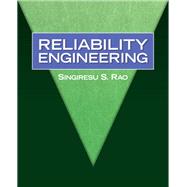Reliability Engineering is intended for use as an introduction to reliability engineering, including the aspects analysis, design, testing, production and quality control of engineering components and systems.
Numerous analytical and numerical examples and problems are used to illustrate the principles and concepts. Expanded explanations of the fundamental concepts are given throughout the book, with emphasis on the physical significance of the ideas. The mathematical background necessary in the area of probability and statistics is covered briefly to make the presentation complete and self-contained. Solving probability and reliability problems using MATLAB and Excel is also presented.








